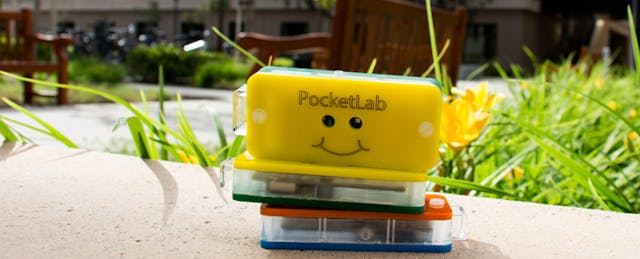If Galileo had access to PocketLab, he could have saved some explanation at the base of the Leaning Tower of Pisa. Luckily, next time you want to share your proof that time of descent is independent from mass, or measure the forces exerted on a Nerf ball during free fall, there’s a new tool available, funded by the Yale Education Business Plan Competition.
The PocketLab sensor, which won the eighth annual conference’s Education Business Plan Competition on April 4, measures force, acceleration, velocity, position, tilt, barometric pressure, altitude, magnetic field, humidity, and temperature. By attaching it to objects, students will be able to measure data from science experiments and transmit their findings to a PocketLab cloud server, enabling classrooms around the world to compare results. “Instead of just showing people what falls faster, a brick or a feather, you can actually just throw the PocketLab out the window, and it will record measurements that you can use to understand what’s going on,” said Aaron Feuer, a judge on the panel at Yale.
Proposals from PocketLab, Million Dollar Scholar, and HomeRoom, selected as the top three applications by the Yale Education Leadership Conference team, were considered in the Business Plan Competition. The competition supports education reform through entrepreneurship by awarding up to $10,000 for seed proposals. This year, it was moderated by EdSurge’s own Tyler McNally, and judged by Aaron Feuer, CEO of Panorama, Sarah Ham, an associate at DBL Investors, Ben Wallerstein, Co-Founder of Whiteboard Advisors, and Kerry Gallagher, a social studies teacher at Reading Public Schools.
Clifton Roozeboom, Adrian Albert, and Michael Ramos-Lynch came up with PocketLab in a management science graduate school course at Stanford, where the three founders respectively study mechanical engineering, electrical engineering, and law and management science. Ramos-Lynch, who taught high school students in Texas through Teach For America, explained the dynamics of their team. “Clif is the hardware guy, Adrian is the software guy, and I’m the education guy,” he said. Speaking from his experience as a teacher, Ramos-Lynch sees PocketLab as addressing “the achievement gap related to STEM fields” by making scientific concepts more personally relevant to students.
Several other sensors already on the market also aim to do so through data collection, analysis, and sharing. National Instruments LabVIEW and the Arduino microcontroller platform offer a similar functionality and network as PocketLab, but are designed for engineers and scientists, rather than students with less expertise. Many widely used interactive learning tools, like Leap Frog, do not offer a social network, as PocketLab hopes to provide through their cloud interface. The Vernier LabQuest2 offers the same tools for collecting and sharing sensor data as PocketLab, but costs substantially more, at $329 per device.
At a cost of $50 for the hardware and $10 annually for the cloud software, PocketLab aims to make these opportunities accessible to students of all economic backgrounds. “Using off-the-shelf components, and components that go into commercial electronics, we can really drive down that price,” Roozebloom explained. Ramos-Lynch added that their supplies would also make PocketLab more durable, especially important in schools with less resources to replace tools. “When you’ve got a high school classroom of 20-40 students, PocketLab is a lot easier to safeguard than the other competitors, which are generally flimsier and way more expensive,” he explained.
With the funding from the Education Business Plan Competition, PocketLab’s founders have made twenty prototypes, and will be testing them within Palo Alto classrooms in the next few weeks. “Our first prototype works best for a high school level understanding of physics, technology, or engineering,” Ramos-Lynch said. For initial live testing, they’re developing lesson plans to roll out with the product. These sample cases--“how a ball bounces, or what motion you see if you hang a weight from a spring, or if you take a car and crash it into a wall, what forces would be involved in that impact,” Ramos-Lynch continued--aim to help teachers integrate PocketLab into high school science curricula.
In future products, they plan to broaden PocketLab’s usability to classrooms from kindergarten through college, and open up the platform to development by other programmers, which would enable teachers in classrooms across grade levels to tailor PocketLab to the needs of a particular student or project. They hope individual students will also be able to use the sensor on their own, making science fairs and robotics competitions less cost-prohibitive.
Future versions of PocketLab will also focus on interacting with a broader community through a cloud interface. This would enable students to better comprehend, analyze, and compare their data, and educators to share and download lesson plans. Roozebloom envisions that students measuring temperature and humidity in a classroom in California would be able to see differences in data from similar experiments across the world, and “start to learn about concepts like local climate, developing global awareness.”
Roozebloom also hopes that the opportunity to learn about deviation and error firsthand would help “students start to learn about these real concepts that plague science understanding when trying to measure something as big as global warming or global climate change.” As he sees it, PocketLab can show the inherent uncertainty in scientific experiments. “We can illustrate that noise in the data on a very micro scale with our sensor, and then on a macro scale, with network access to others’ data,” said Roozebloom.
To Gallagher, who teaches at Reading Memorial High School in Massachusetts, PocketLab offers an opportunity for students to not only grasp global changes, but also understand the science at work in their daily lives. She envisions students bringing the PocketLab out of the classroom, using it to “learn the physics of what they do all the time,” by placing the sensor inside a baseball, on a sled, or strapping it to an arm during a dance routine. Roozebloom agrees, explaining, “one of the big goals is to turn everyday experiences into hands-on experiments.” So pull out your Nerf ball, or your sled: PocketLab is coming your way.


